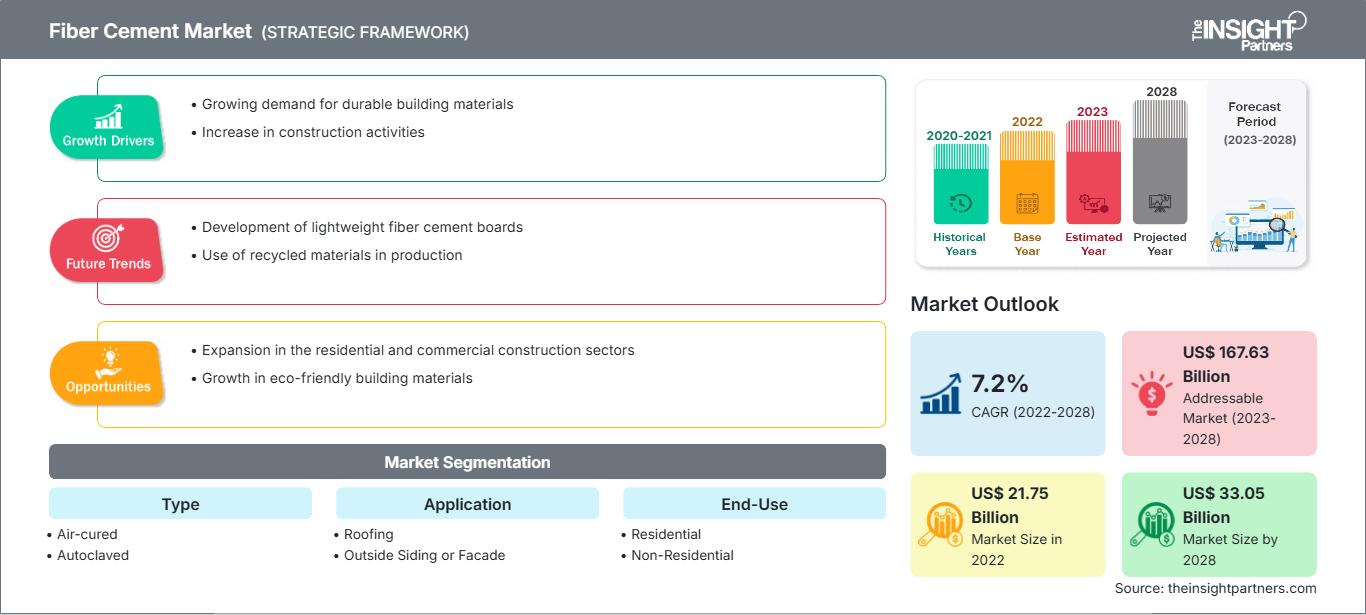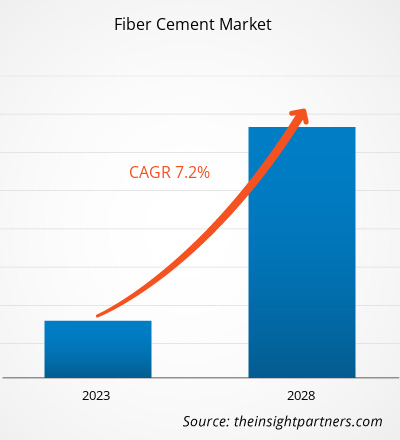[Rapport de recherche] Le marché du fibrociment devrait passer de 21 748,45 millions de dollars américains en 2022 à 33 052,23 millions de dollars américains en 2028 ; il devrait enregistrer un TCAC de 7,2 % entre 2022 et 2028.
Le fibrociment est couramment utilisé comme matériau de revêtement extérieur car il offre une excellente durabilité et une excellente résistance aux intempéries et au feu. De plus, il est souvent utilisé comme matériau de toiture en raison de sa capacité à résister aux conditions climatiques difficiles, telles que les fortes pluies, la grêle et le vent. De plus, le fibrociment peut également être utilisé pour les finitions et les bordures de toit, car il est facile à façonner et peut être peint ou teinté pour s'harmoniser avec l'extérieur du bâtiment. Il est également fréquemment utilisé dans les bâtiments commerciaux, tels que les hôpitaux, les écoles et les immeubles de bureaux, car il offre une option durable et nécessitant peu d'entretien pour leurs extérieurs.
En 2022, l'Asie-Pacifique détenait la plus grande part de chiffre d'affaires du marché mondial du fibrociment. La demande de fibrociment augmente en Asie-Pacifique en raison de la sensibilisation croissante à ses avantages. Cette région est reconnue comme l'un des marchés les plus importants pour l'utilisation de panneaux de fibrociment en raison de l'essor des activités de construction. De plus, les initiatives et politiques gouvernementales telles que Make-in-India encouragent l'implantation de différentes usines de fabrication en Inde. L'augmentation des investissements directs étrangers entraîne également une croissance économique dans la région. Le nombre croissant d'utilisations de panneaux de fibrociment dans de nombreux secteurs résidentiels et non résidentiels devrait accroître la demande de panneaux de fibrociment en Asie-Pacifique dans les années à venir. En Inde, le secteur de la construction est le deuxième secteur industriel après l'agriculture, représentant environ 11 % du PIB du pays. Le secteur du bâtiment et L'industrie de la construction contribue fortement à la croissance du marché.
Personnalisez ce rapport en fonction de vos besoins
Vous bénéficierez d’une personnalisation sur n’importe quel rapport - gratuitement - y compris des parties de ce rapport, ou une analyse au niveau du pays, un pack de données Excel, ainsi que de profiter d’offres exceptionnelles et de réductions pour les start-ups et les universités
Marché du fibrociment: Perspectives stratégiques

-
Obtenez les principales tendances clés du marché de ce rapport.Cet échantillon GRATUIT comprendra une analyse de données, allant des tendances du marché aux estimations et prévisions.
Impact de la pandémie de COVID-19 sur le marché du fibrociment
Le secteur de la construction a été le principal contributeur à la demande de fibrociment. La pandémie de COVID-19 a eu un impact négatif sur la croissance du secteur des produits chimiques et des matériaux et sur le marché du fibrociment. La mise en œuvre de mesures pour lutter contre la propagation du SARS-CoV-2 a eu un impact négatif sur la croissance de diverses industries. Des industries telles que l'emballage, les biens de consommation, l'automobile et les transports, le textile et le bâtiment et la construction ont été affectées par les perturbations de l'efficacité opérationnelle et des chaînes de valeur dues à la fermeture soudaine des frontières nationales et internationales. Pendant la pandémie de COVID-19, la baisse des revenus et les difficultés croissantes de réalisation des projets ont entraîné une contraction du secteur sur la plupart des marchés, avec un impact négatif correspondant sur la main-d'œuvre. Les constructeurs ont subi des retards et une augmentation des coûts des matières premières importées et des matériaux de construction hors site en raison de la fermeture prolongée de nombreuses usines. Les dommages causés au bâtiment et L'industrie de la construction a freiné la demande de fibrociment pendant la pandémie.
Aperçu du marché
La forte demande de bâtiments écoénergétiques stimule la croissance du marché du fibrociment
Selon le Programme d'aide à la gestion du secteur de l'énergie, près d'un tiers de l'énergie mondiale est consommée dans les bâtiments résidentiels, publics et commerciaux pour le refroidissement des espaces, le chauffage, la ventilation, la cuisson, la réfrigération, l'éclairage, le chauffage de l'eau et le fonctionnement des appareils électriques et mécaniques. La modernisation des villes dans les pays en développement et l'augmentation du revenu par habitant stimulent la consommation d'énergie dans les bâtiments du monde entier. La forte consommation d'énergie dans les bâtiments publics, résidentiels et commerciaux crée un besoin d'économies d'énergie. Selon l'Agence internationale de l'énergie, les bâtiments devraient représenter 41 % du potentiel mondial d'économies d'énergie d'ici 2035, et le secteur industriel et le secteur des transports en détiendront respectivement 24 % et 21 %. Une couche de fibrociment est appliquée sur le bâtiment pour réduire le transfert de chaleur à travers les murs, gardant l'intérieur plus chaud en hiver et plus frais en été, ce qui contribue à réduire la consommation d'énergie. Selon le manuel ASHRAE Fundamentals Handbook, le fibrociment a une valeur R de 0,15, ce qui est supérieur à la valeur de la brique et de la pierre.
Informations sur les types
Selon le type, le marché mondial du fibrociment se divise en deux catégories : le fibrociment à l'air libre et le fibrociment autoclavé. Le segment autoclavé détenait une part de marché plus importante en 2022. Le fibrociment autoclavé est fabriqué à partir d'un mélange de ciment, de sable, de fibres de cellulose et d'autres additifs. Le mélange est formé en feuilles ou en panneaux, puis durci dans un autoclave, un récipient à haute pression qui applique de la chaleur et de la vapeur au matériau. Le processus d'autoclavage provoque une réaction chimique qui renforce le matériau, le rendant plus durable et résistant à l'eau, au feu et aux nuisibles. Il est généralement utilisé dans une large gamme d'applications, notamment pour la toiture, le bardage, les revêtements de sol et comme support pour les carreaux en béton armé. De plus, le fibrociment autoclavé est également reconnu pour sa polyvalence et sa flexibilité de conception, car il peut être fabriqué pour imiter l'apparence d'autres matériaux de construction, comme le bois ou la pierre. Il est également disponible en différentes couleurs et textures, ce qui en fait un choix populaire pour les projets de construction résidentiels et commerciaux. JamesHardie Industries plc, Etex NV, Swisspearl Group AG, CSR Ltd, NICHIHA Corp, Plycem Construsistemas Costa Rica SA, Compagnie de Saint Gobain SA, Century Plyboards Ltd, Everest Industries Ltd et Isam Khairi Kabbani Group comptent parmi les principaux acteurs du marché mondial du fibrociment. Ces acteurs se concentrent sur la fourniture de produits de haute qualité pour répondre à la demande des clients. Ils adoptent également des stratégies telles que l'investissement dans la recherche et le développement et le lancement de nouveaux produits. .
Points forts du rapport
- Tendances progressives du secteur sur le marché du fibrociment pour aider les acteurs à développer des stratégies efficaces à long terme
- Stratégies de croissance adoptées par les marchés développés et en développement
- Analyse quantitative du marché du fibrociment de 2020 à 2028
- Estimation de la demande mondiale de fibrociment
- Analyse des cinq forces de Porter pour illustrer l'efficacité des acheteurs et des fournisseurs opérant dans le secteur
- Évolutions récentes pour comprendre le scénario concurrentiel du marché
- Tendances et perspectives du marché, ainsi que facteurs stimulant et freinant la croissance du marché du fibrociment
- Aide à la prise de décision en mettant en évidence les stratégies de marché qui sous-tendent l'intérêt commercial, conduisant à la croissance du marché
- Taille du marché du fibrociment à différents nœuds
- Aperçu détaillé et segmentation du marché, ainsi que de l'industrie du fibrociment dynamique
- La taille du marché du fibrociment dans diverses régions avec des opportunités de croissance prometteuses
Aperçu régional du marché du fibrociment
Les tendances régionales et les facteurs influençant le marché du fibrociment tout au long de la période de prévision ont été analysés en détail par les analystes de The Insight Partners. Cette section aborde également les segments et la géographie du marché du fibrociment en Amérique du Nord, en Europe, en Asie-Pacifique, au Moyen-Orient et en Afrique, ainsi qu'en Amérique du Sud et en Amérique centrale.
Portée du rapport sur le marché du fibrociment
| Attribut de rapport | Détails |
|---|---|
| Taille du marché en 2022 | US$ 21.75 Billion |
| Taille du marché par 2028 | US$ 33.05 Billion |
| TCAC mondial (2022 - 2028) | 7.2% |
| Données historiques | 2020-2021 |
| Période de prévision | 2023-2028 |
| Segments couverts |
By Type
|
| Régions et pays couverts |
Amérique du Nord
|
| Leaders du marché et profils d'entreprises clés |
|
Densité des acteurs du marché du fibrociment : comprendre son impact sur la dynamique des entreprises
Le marché du fibrociment connaît une croissance rapide, portée par une demande croissante des utilisateurs finaux, due à des facteurs tels que l'évolution des préférences des consommateurs, les avancées technologiques et une meilleure connaissance des avantages du produit. Face à cette demande croissante, les entreprises élargissent leur offre, innovent pour répondre aux besoins des consommateurs et capitalisent sur les nouvelles tendances, ce qui alimente la croissance du marché.

- Obtenez le Marché du fibrociment Aperçu des principaux acteurs clés
- Analyse historique (2 ans), année de base, prévision (7 ans) avec TCAC
- Analyse PEST et SWOT
- Taille du marché Valeur / Volume - Mondial, Régional, Pays
- Industrie et paysage concurrentiel
- Ensemble de données Excel
Rapports récents
Rapports connexes
Témoignages
Raison d'acheter
- Prise de décision éclairée
- Compréhension de la dynamique du marché
- Analyse concurrentielle
- Connaissances clients
- Prévisions de marché
- Atténuation des risques
- Planification stratégique
- Justification des investissements
- Identification des marchés émergents
- Amélioration des stratégies marketing
- Amélioration de l'efficacité opérationnelle
- Alignement sur les tendances réglementaires






















 Obtenez un échantillon gratuit pour - Marché du fibrociment
Obtenez un échantillon gratuit pour - Marché du fibrociment